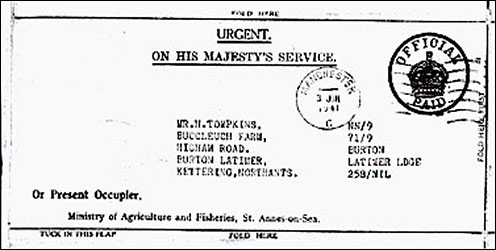| By John Meads | |||
|
|||
|
In 1941, the Ministry of Agriculture and Fisheries commissioned a survey of all land in This Farm Survey is very useful in drawing up a ‘snapshot’ of the state of British farms and smallholdings in the early 1940s and is an invaluable tool for local historians. From this survey we find that in 1941, Buccleuch Farm comprised 248 acres, of which 152 were arable. The tenant was Mr. H. Tompkins and his farm also included Glendon Lodge Farm, to the east, just over the A6 trunk road. Part of the land that belonged to Glendon Lodge had been requisitioned by the War Department and the farmhouse was used as a farm worker’s cottage. The land, like so much more in that part of Burton Latimer, was owned by Richard Thomas Ltd. of Irthlingborough, which had extensive underground ironstone workings under the fields that stretched from Irthingborough and Finedon almost to The farm had no electricity and no running water, a deep well was the only water supply on the farm apart from ponds in a few fields, although the survey notes that eleven fields had no access to water and there was a seasonal shortage. 80% of the soil was classed as heavy and the remainder medium; 14 acres attached to Glendon Lodge was classed as bush land. The Inspector commented that the land had been in a bad condition when the present tenant had taken it over two years previously, but that he had energetically tackled ditches and hedges and improved the farm with better cultivation and, at Glendon Lodge Farm, until 18 acres had been requisitioned, he was reclaiming derelict bush land. This work had now been postponed until the land was released by the War Department. There were 62 acres of wheat and 25 acres of oats with 28 acres fallow. Over 120 acres were grass, which supported 19 cattle and calves and 92 sheep and lambs. There was a ¼ acre orchard and 17 fowls and geese. There was one man working full time on the farm and two part-timers. Three horses were used, together with a 20 h.p. Fordson tractor and a 4½h.p. petrol engine to supply power in the absence of mains electricity. The annual rent was £130. |
|||
